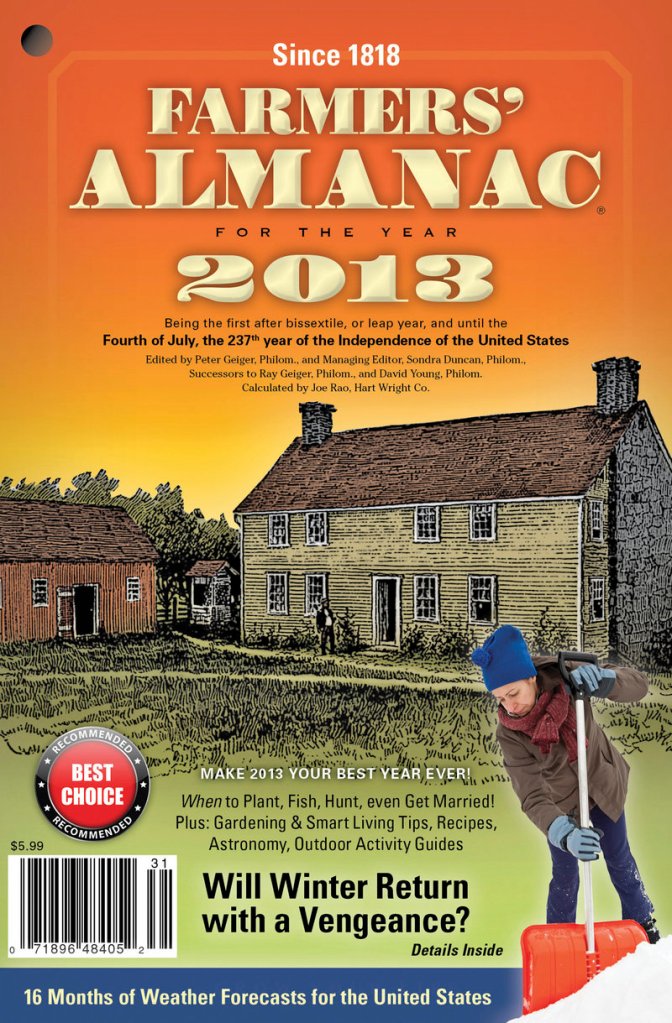Eric Sideman, a crop specialist with the Maine Organic Farmers and Gardeners Association, doesn’t rely on a farmers’ almanac for useful information, and he doesn’t know anyone who does.
“My opinion is that it’s fun to read but it’s not based in any science that I can tell,” he said. “I would say it’s like reading a horoscope.”
For the forecast, he goes online to see what the National Weather Service has to say.
News this week that the publisher of the Farmers’ Almanac plans to lay off 75 employees and phase out its printing and manufacturing business prompts a broader question about a publication that trades in nostalgia: In an age when information is instantly available on the Web and mobile devices, do people have any use for a folksy, old-fashioned publication that predicts the weather more than a year in advance?
Peter Geiger, whose Lewiston-based company, Geiger, produces the well-known periodical, said the layoffs will not affect the almanac. He declined to talk Wednesday about the publication’s future, indicating that he wants the dust to settle first.
On Tuesday, he said his company will stop manufacturing products such as planners, calendars, journals and pocket diaries — which represent 10 percent of its business — because technological advances such as smartphones and tablets have reduced demand. (According to Wikipedia, the Farmers’ Almanac sells more than 4 million copies a year.)
Janice Stillman, editor of the similarly themed Old Farmer’s Almanac, said it would be natural to assume that technological advances would similarly affect sales of almanacs, but sales of her publication — over 3 million — have been steady for years, even in the digital age.
“I didn’t grow up with an almanac in the house, so I really didn’t understand the variety of information until I came here,” she said Wednesday in a telephone interview from her office in Dublin, N.H. “It’s not just weather.”
The Old Farmer’s Almanac is published in New Hampshire by Yankee Publishing, which also produces Yankee Magazine.
The Farmers’ Almanac is produced in Maine but printed and bound elsewhere.
The two have been rivals for almost 200 years. Stillman said there has always been confusion about which is the real one.
“When people talk about a farmers’ almanac, it’s a generic term. There are probably dozens across the country,” she said.
The almanacs are folksy blends of recipes, gardening tips, jokes, facts and trivia. For years, they were essential and treasured publications for farmers, gardeners and anyone else whose business was affected by weather. The 2013 Farmers’ Almanac provides weather forecasts for the United States for the next 16 months.
In the era of smartphones and tablets, it seems the paperback books sell more for their nostalgic value than their relevance.
Frank Wertheim, an educator with the University of Maine’s Cooperative Extension office in York County, said he sees farmers’ almanacs as something of a relic.
“They maybe had more use a few decades ago, but it’s probably more nostalgia now than anything else,” he said.
Wertheim said almanacs’ predictions for weather a year ahead may have been OK a generation or two ago, but now there are much more sophisticated and accurate ways to predict long-term weather trends.
For years, editors of the Farmers’ Almanac and the Old Farmer’s Almanac have refused to reveal how they arrive at their respective weather predictions. But even if the forecasts are flimsy, the almanacs still have some appeal.
Pete Morse, a charter fisherman based in South Portland, lives on what he calls a “gentleman’s farm” in Buxton. Between his life on the ocean — he used to be a lobsterman — and his interest in farming, Morse said, he has found farmers’ almanacs to be interesting reading.
“I’m pretty old-fashioned,” said Morse, who’s 43. “I don’t base my vacation trips on it, but I’m surprised how accurate it is in terms of overall predictions about seasons.”
Morse said he’s not sure if the almanac he reads is the Maine-based Farmers’ Almanac or the New Hampshire-based Old Farmer’s Almanac.
“I think I’ve read both,” he said.
At Longfellow Books in Portland’s Monument Square, a couple of copies of the Old Farmer’s Almanac were on the shelf Wednesday, but the Farmers’ Almanac wasn’t.
An employee said Longfellow Books stopped selling the Maine-based almanac in 2007. But it still can be found elsewhere, including checkout lines at grocery stores.
Staff Writer Eric Russell can be contacted at 791-6344 or at:
erussell@pressherald.com
Twitter: @PPHEricRussell
Send questions/comments to the editors.





Success. Please wait for the page to reload. If the page does not reload within 5 seconds, please refresh the page.
Enter your email and password to access comments.
Hi, to comment on stories you must . This profile is in addition to your subscription and website login.
Already have a commenting profile? .
Invalid username/password.
Please check your email to confirm and complete your registration.
Only subscribers are eligible to post comments. Please subscribe or login first for digital access. Here’s why.
Use the form below to reset your password. When you've submitted your account email, we will send an email with a reset code.